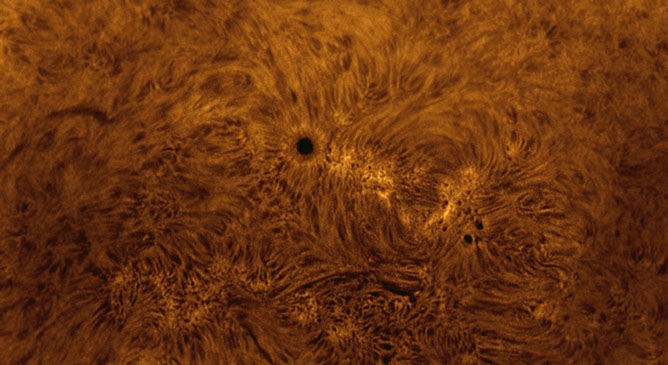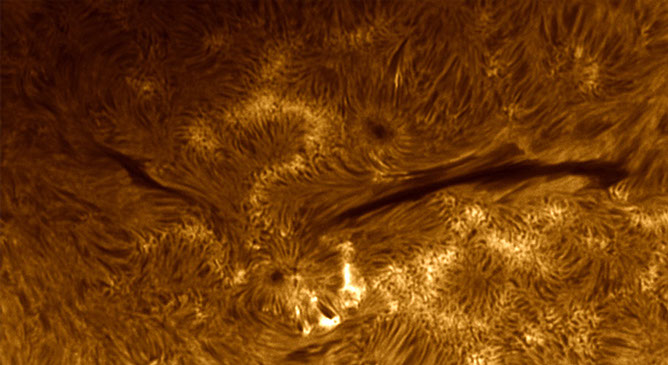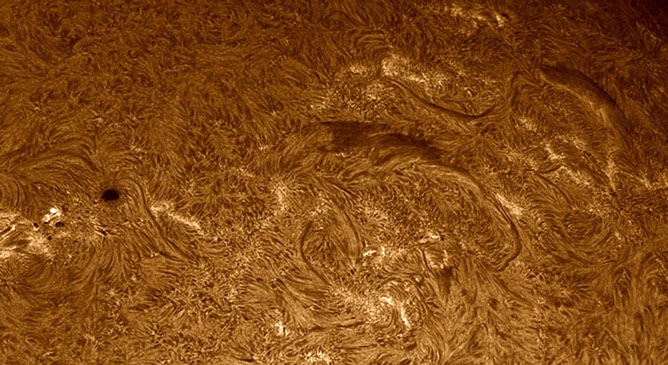
Daystar’s Quark hydrogen-alpha ‘eyepiece’. Image: Daystar.
DAYSTAR’S
QUARK
HYDROGEN-ALPHA ‘EYEPIECE’
David Arditti tests out a new hydrogen-alpha filter for refractors marketed as ‘quick, cheap, easy and fun’.
American company Daystar has a respected name in the solar telescope field. For many years they have been producing, amongst other products, high-grade hydrogen-alpha filters that fit to the eye end of a telescope. In contrast to the type of filter that goes at the objective end, or is fixed inside, this design necessitates adding a Barlow lens first to make the light from the objective sufficiently parallel for the filtration to work. The best of these eye-end hydrogen-alpha filters also use a heating element to raise the filter to a precisely-regulated temperature at which it is optimally ‘on band’ to reveal the chromospheric surface details.
A new twist to an old idea
The new Daystar Quark ‘eyepiece’ is actually not an eyepiece at all, but a new manifestation of this eye-end filter idea: a cylindrical unit the size of a large two-inch eyepiece that fits in the draw-tube or diagonal of your existing refractor, and takes a 1.25-inch eyepiece or a camera nosepiece. It comes with a power supply for the heater and has a knob that adjusts the temperature to alter the tuning of the pass frequency. Importantly, it is set at a price point well below other Daystar filters, and below all but the smallest (40mm aperture and under) dedicated hydrogen-alpha telescopes. It has a smart anodised black and red aluminium housing, with both two-inch and 1.25-inch barrels, and a brass compression fitting for the eyepiece.
The specially optimised Barlow, which gives an amplification of 4.2 times and contains its own blocking filter, is built-in and cannot be substituted for another one as it has special coatings and Daystar have given it a unique thread. The Quark is said to be compatible with f/4 to f/9 refractors. For telescopes of less than 120mm aperture, Daystar suggest using an ultraviolet and infrared cut-off filter (not supplied) screwed on in front of the diagonal, which reflects these invisible wavelengths back up the telescope to prevent the focal area from getting too hot. This cannot work with an oil-spaced objective or a Petzval telescope and above 120mm aperture, Daystar recommend an energy rejection filter be used over the objective instead. For brief observing sessions with a telescope under 80mm aperture on a non-tracking mount, Daystar say that having no other filter may be satisfactory, but I did not risk this.

A filament imaged through the Quark using a DMK 41AU02.AS camera and a 66mm f/5.9 refractor, on 29 June 2014. Image: David Arditti.
This review first appeared in our August 2014 issue.

The Quark comes in two editions at the same price, a ‘chromosphere’ version and a ‘prominence’ version. The former is quoted with a bandpass of 0.5 to 0.3 Ångstroms (0.05 to 0.03 nanometres) depending on your telescope’s f-ratio, while the latter has a bandpass of 0.8 to 0.6 Ångstroms. However, as the prominences are nicely visible in the chromosphere version (which I tested), I am not clear why anyone would want to pay the same for the wider bandpass version that is only capable of showing prominences.
Consider your focal lengths
Comparing the image using the Quark on the 66mm refractor with the view through my Lunt LS60T double-stacked hydrogen-alpha telescope I found that the Quark view was far more uniform, with detail visible simultaneously across the Sun’s disc and around the chromospheric ring, whereas the view through the Lunt had higher contrast in its ‘sweet spot’, but required the Sun to be moved around the field to see the details in all areas. The contrasts in the disc features (filaments and active areas) through the Quark were fairly subtle and required a bit of time to trace, though all the same features were there. Top-quality front-end filter systems that I have observed through give higher contrast and the same uniformity, but it must be noted the Quark is a fraction of the price of these. The Quark on the end of the 100mm f/9 proved a good system for observing detail in prominences, although the minimum magnification was too high to really get a good impression of the surface.
Use your diagonal correctly
Use of a diagonal needs a bit of consideration. A two-inch diagonal can only go between the telescope and the Quark. A 1.25-inch diagonal could go either side, but the arrangement would be more stable if you placed the diagonal after the Quark. This might necessitate putting a draw-tube extension on a telescope with ample back-focus, as the Barlow in the Quark is telecentric, meaning it requires to be at a certain distance from the objective. On a telescope with limited back-focus, a 1.25-inch diagonal placed after the Quark might be the only diagonal viewing option.
The Quark on a two-inch diagonal. Image: Daystar.








Images taken with the Quark by Gary Palmer. www.solarsystemimaging.co.uk
Images taken with the Quark by Gary Palmer. www.solarsystemimaging.co.uk
Images taken with the Quark by Gary Palmer. www.solarsystemimaging.co.uk
Images taken with the Quark by Gary Palmer. www.solarsystemimaging.co.uk
Images taken with the Quark by Gary Palmer. www.solarsystemimaging.co.uk
Images taken with the Quark by Gary Palmer. www.solarsystemimaging.co.uk
Images taken with the Quark by Gary Palmer. www.solarsystemimaging.co.uk
Images taken with the Quark by Gary Palmer. www.solarsystemimaging.co.uk
1 - 8
<
>

The Quark in straight-through imaging configuration on a 100mm refractor. Image: David Arditti.
Another issue to think about is the power supply. The supplied mains unit and lead is not going to be very convenient unless you have an observatory. Fortunately the retailer also supplied me with a five-volt rechargeable USB battery. If you are going to be doing public observing, you need to weigh up how convenient it is to have a device that requires power, with a lead that can be easily pulled out. I found the Quark takes about 15 minutes to get to temperature; again, in the cloudy climate of the UK, this is a potential disadvantage as your window of clear skies might be gone by the time it is on-band.
To use a camera with a Quark requires it to have a 1.25-inch nosepiece. Daystar have not supplied the unit with a T-thread, which would have been better; I suggest they think about the imaging application more carefully. I took some images with the 66mm and 100mm telescopes with a DMK camera and a Lumenera camera and, although conditions were not optimal, I think I showed that the device has serious imaging potential.
The Quark is an effective and well-priced product for opening up the vistas of detailed solar hydrogen-alpha observing and imaging to refractor owners, subject to the reservations on focal length I make above. For visual use I think it is really best suited to the shortest instruments; it would be good if Daystar could produce a version with less powerful amplification for longer refractors. I suspect it will prove most attractive to those taking a small telescope and mount on holiday to a dark site, who would like to add a high-grade solar capability without carrying too much extra luggage. For this purpose the Quark would be excellent.
AT A GLANCE
Dimensions: 56mm diameter, 146mm long
Weight: 400g
Bandpass: 0.8–0.6 Å (prominence edition), 0.5–0.3 Å (chromosphere edition)
Blocking filter aperture: 12mm
Power supply: 5V 1.5A USB
Price: £799
Available from: Astrograph (astrograph.net)
Details: www.daystarfilters.com/Quark.shtml
Home • Current issue • iPad/iPhone • Subscribe • Store • European AstroFest